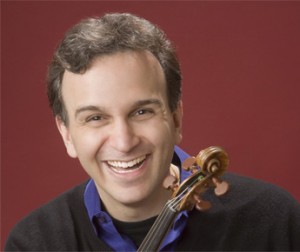It was in 1991 that the famed Boston Symphony Orchestra (BSO), one of the oldest ensembles in the United States (it was founded in 1881; the LA Phil, by comparison, was founded in 1919) last performed in Los Angeles, and that was in the LA Phil’s then-home at the Dorothy Chandler Pavilion.
On Dec. 10, the BSO returned to LA to cap off a five-city tour of California. Under the direction of the relatively unknown (at least to Los Angeles audiences) French conductor, Ludovic Morlot, the BSO presented an ambitious program of three large-scale works, including the Violin Concerto in D major, Op. 77 by Johannes Brahms with Gil Shaham as soloist, the Symphony No. 4 by John Harbison, and the Daphnis and Chloé, Suite No. 2 by Maurice Ravel.
Even though Morlot may not be familiar to LA audiences, he is well known in Boston, having served as assistant conductor to the Boston Symphony Orchestra and James Levine from 2004-06 after having been a Seiji Ozawa Conducting Fellow at the Tanglewood Music Center in 2001. The BSO must really like him because following two weeks of programs in Boston this November, he was picked to lead the orchestra in its West Coast tour culminating last night at Disney Hall. And last night Morlot showed why he will now be on our radar.
As numerous writers have pointed out, the acoustics in Disney Hall are tricky, especially for musicians who have never performed there. At least a visiting orchestra that performs a few concerts gets more than one chance to tweak its sound to the sensitive hall. But Morlot and the BSO got only one shot — and they hit it out of the park. It is rare for a visiting orchestra to sound as good in Disney Hall as the BSO did last night.
The concert opened with the Brahms, and as soon as the first few notes of the opening theme, played by the violas, cellos, and bassoons, and joined after three bars by the horns, began, it was clear that this was going to be a special night. And so it was.
As great as Disney Hall is acoustically, one perennial drawback is the difficulty of hearing string soloists especially when the orchestra is playing. But Morlot performed a feat of magic in getting the BSO to play superbly without ever stepping on Shaham’s toes. This, despite the fact that Shaham spent considerable time facing Morlot and the second violins and violas while playing, almost as if he was too modest or shy to face the audience. Of course, Brahms helped Morlot with his modest classical scoring for the concerto (two flutes, oboes, clarinets, bassoons, trumpets, four horns, and strings).
Shaham’s performance was one of restrained beauty and lyricism, just like Brahms’ concerto itself, and one could tell not only from Shaham’s playing but also from his facial expressions that he clearly loves this concerto. And the audience loved his performance.
Another standout in the Brahms was the BSO’s principal oboist, John Ferrillo, whose powerful, yet lyrical playing, especially in the solo to begin the second movement, revealed a new dimension of the solo.
In the Brahms, the BSO sounded like the finest of aged wine, deep, buttery, full-bodied, and balanced. When Morlot and the BSO launched into the Harbison, to begin the second half of the concert, with its opening “brash fanfare,” in Harbison’s words, it was a different BSO — not the aged wine of the Brahms, but the bold, clean, and crisp sound of an orchestra that since its founding has featured American premieres of numerous 20th century masterpieces. Moreover, it boasts two of the greatest French conductors of all time, Pierre Monteux and Charles Munch. Thus, the BSO brought a strong French connection to Disney Hall.
The performance of the Harbison Symphony No. 4 is part of the BSO’s two-season survey of all six symphonies, the last two of which were commissioned by the BSO. The Fourth Symphony was commissioned by the Seattle Symphony Orchestra of which Maestro Morlot is their newest music director — but there is also apparently an LA connection. According to the publisher’s website, Harbison is quoted as saying:
In some way the Symphony began with a summer drive to the Hollywood Bowl in 1986, my first day in L.A., with the person who became my best friend there, Deborah Card. She has “collaborated” with me on The Most Often Used Chords for the LA Chamber Orchestra, and again on this fourth symphony.
Harbison’s fourth symphony combines elements of traditional melodies and harmonies with more contemporary harmonies, rhythms, and coloration in a very accessible work. Moreover, the audience probably heard the definitive version, confirmed by the composer taking bows on stage afterwards.
The concert concluded with a ravishing version of an already ravishing work, the Suite No.2 from Ravel’s masterpiece, Daphnis and Chloé (the premiere was conducted by Pierre Monteux in 1912). Morlot and the BSO capped off a concert featuring two relatively long and demanding works with Ravel’s musically and orchestrally lush work featuring a number of standout performances, including the magical playing by principal flutist, Elizabeth Rowe. One could almost hear the footsteps of Monteux and Munch in the hall.
But even after an already full program that would have sent any audience home completely satisfied, the crowd wanted more — a dessert wine perhaps? And Morlot obliged with a rousing version of a work by another French composer, the Roman Carnival Overture by Berlioz, which brought even more cheers and applause for so long that Morlot had to physically lead the orchestra off the stage.
Those in attendance on Saturday night witnessed un concert exceptionnel by one of the world’s great orchestras with a young conductor to keep your eyes and ears on.
—Henry Schlinger, Culture Spot LA







